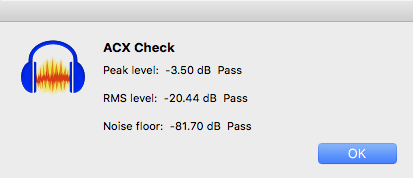Hello Audacity Team!
First time posting. I stopped working with ACX because Logic Pro X was providing me incorrect (or different) information as to my audio’s RMS and peak levels so that my last ACX job was a nightmare. I had to keep nudging the audio around hoping it would pass QC. My past work had always passed and was sold on the marketplace, but this one particular book suddenly had audio issues. These issues were that the RMS and peak levels did not meet the requirements of ACX EVEN THOUGH when I used the Logic Pro X 10.5.1 Multimeter these measurements were clearly within the restrictions. When consulting with ACX, I learned that audio can be read differently depending on what software is doing the reading. I understand that this could be possible, but then again how could I (or anyone) ever be absolutely sure that their audio is being recorded properly and/or processed properly for any end user?
That’s how I came to discover Audacity Team and your open-source plugins, primarily ACX Check. What a god send, I thought. Now I just have to learn how to create a chain (or macro) of plugins and my final process will be to run the ACX Check before submitting my mixed and mastered audio. Well, I have been having trouble there too. I still have to nudge audio around to fit it within its limits and so many tools that I’m used to as a Logic user are not available or are more time consuming. I have now been trying to record and process audio in Logic using EQ, peak compression, RMS compression, etc and importing those bounced files into Audacity to use ACX Check to read the files more succinctly.
My latest problem is that Audacity appears to read my processed files bounced from Logic differently. I’m back to where I started, I think. Where Logic’s multimeter tells me that the attached file peaks at -2.8 and that the track has an RMS of 19.5 Audacity reads the same track as having a park of -0.1 and an RMS of -26.7. Either every software really does read audio data differently which in that case my question is: How can I always know that my completed audio files will be accepted by ACX? Or the problem is that I am not using these DAWs’ plugins correctly to which my question is then: How do you read a DAWs’ plugins to get a numeric value that I’m possibly misreading?
I have attached this test file to the post so that it can be analyzed. I’m really at a loss here, guys. I’ve read many articles on loudness, metering, compression and watched many tutorials on the subject of mixing/mastering for ACX delivery but I would really appreciate your help on this specific problem I’m having either with these concepts or with misreading data.
Best,
Jamie
MacOS Catalina 10.15.5
Audacity 2.4.2


